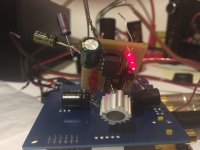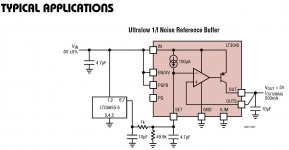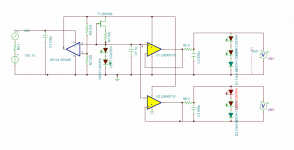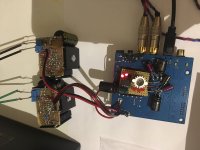Outrageous as it is, 8nV/rtHz over 20 kHz bandwidth is about -126 dB from 2 Vrms, so a 5532 would be roughly equivalent to the SNR "spec" of the latest ESS chips. (Assuming a rather low network impedance around said 5532)
Not that I disagree with your point in the least, Martin!
Not that I disagree with your point in the least, Martin!
Last edited:
That's the @30hz rating for the dual 5534; otherwise it's 5nV/rtHz
The single opamp version- the venerable NE5534: 3.5nV/rtHz. (which is what I had in mnd TBH, when I posted) - not bad 😉
The single opamp version- the venerable NE5534: 3.5nV/rtHz. (which is what I had in mnd TBH, when I posted) - not bad 😉
Not in the least! 🙂
I backed out the -126 to it's equiv nV/rtHz, and when you account for current noise, we're in the ballpark of these opamps. Mind you, we're not disagreeing!
I backed out the -126 to it's equiv nV/rtHz, and when you account for current noise, we're in the ballpark of these opamps. Mind you, we're not disagreeing!
Not at all 🙂
But like anything - datasheet figs are one thing; extracting anything like that declared performance is/can be quite another.
And even if one gets close to it - whether you like the result is a thing that, as Lord Kelvin noted c.130years ago, '..comes to the ear for judgement'.
Lies, damn lies and statistics; or - audio preferences; what actually does that thing for each of us, on our own terms, in our own time, for our own pleasure cannot be defined by singular graphs and figures-of-merit... I think 'pretty good' numbers a necessary, but perhaps not sufficient condition. The rest of you will have your own aesthetics just as valid 🙂
But like anything - datasheet figs are one thing; extracting anything like that declared performance is/can be quite another.
And even if one gets close to it - whether you like the result is a thing that, as Lord Kelvin noted c.130years ago, '..comes to the ear for judgement'.
Lies, damn lies and statistics; or - audio preferences; what actually does that thing for each of us, on our own terms, in our own time, for our own pleasure cannot be defined by singular graphs and figures-of-merit... I think 'pretty good' numbers a necessary, but perhaps not sufficient condition. The rest of you will have your own aesthetics just as valid 🙂
Last edited:
Yes, it can do much better, wideband; and it gives you complete control of how it reacts into your prospective load.
The post a few above calling the NE5534 'noisy' made me giggle! You have to have things really wrong (layout, supply bypassing, surce impedances) to make a 5532 'noisy'. Feed it with a low source impedance and it's about as noisy as, what, a 500ohm resistor, if that. I can't readily think of a situation where it would be the prime noise-source in a circuit.
(and if you can't readily push the limits of a NE553x, you are not likely to benefit from an AD797... nor keep such a thing happy in-circuit)
NE5534 is noisy if you're comparing voltage noise to AD797, ADA4898, or OPA1611. I think Jens knows how to use an NE5534...
I may be reading the datasheet wrong, but the voltage noise of LT3045 is quieter than an NE5534 from 100Hz onward with a 22uF Cset.
I see little reason to use anything but an LT3042/LT3045. The transient response / bandwidth and questionable stability of a cap-swamped op-amp is less appealing to me. The ESS AVCC pins requiring up to 90mA don't seem like a typical VREF pin and may not be as nice of a load?
Last edited:
Hi guys!
I have a greate news!
As I mentioned yesterday I had finalized a built which could have been attached to the ES9038.
My first impression was terrible. I fought several hours during nights for nothing.
BUT:
Today I changed the OPA2 from NE5532 first to OPA2134 and afterwards to LME49720.
Here - as Mark suggested to eiminate the output resistor much earlier - I could decrease it to 0. Furthermore I could increase the capacity on the AVCC. (there is roughly 800uF (as a sum of different CAPs).
Furthermore I replaced the OPA1 from NE5534 to OPA134 (originally I wanted to have some high current output one (like LM7171) but nothing was in the small shop in our town.
And a small miracle happened:
The dark bass disappered!
I have a really clear voice.
The bass is very bright, the stage is really wide.
Currently the phisical state is terrible, I tried several things - you can see the result . I will clean it up, but the voice is a really huge step.
Soon you can see the finalized circuit. OK not finalized, since always can be developed further ;-)
I have a greate news!
As I mentioned yesterday I had finalized a built which could have been attached to the ES9038.
My first impression was terrible. I fought several hours during nights for nothing.
BUT:
Today I changed the OPA2 from NE5532 first to OPA2134 and afterwards to LME49720.
Here - as Mark suggested to eiminate the output resistor much earlier - I could decrease it to 0. Furthermore I could increase the capacity on the AVCC. (there is roughly 800uF (as a sum of different CAPs).
Furthermore I replaced the OPA1 from NE5534 to OPA134 (originally I wanted to have some high current output one (like LM7171) but nothing was in the small shop in our town.
And a small miracle happened:
The dark bass disappered!
I have a really clear voice.
The bass is very bright, the stage is really wide.
Currently the phisical state is terrible, I tried several things - you can see the result . I will clean it up, but the voice is a really huge step.
Soon you can see the finalized circuit. OK not finalized, since always can be developed further ;-)
Attachments
Last edited:
I see little reason to use anything but an LT3042/LT3045. The transient response / bandwidth and questionable stability of a cap-swamped op-amp is less appealing to me. The ESS AVCC pins requiring up to 90mA don't seem like a typical VREF pin and may not be as nice of a load?
That's my takeaway, too. Use it for Vref, and then a voltage divider with a cap from the midpoint on the Vref/2 point for the I/V.
I/V uses Vref, not Vref/2. It is that Vref = 1/2AVCC, and LT3045 would be used for AVCC. Right?
So, how about doing as the LT3045 data sheet suggests and use LTC6655 as the reference for LT3045? That should be the hot setup for DACs, at least it seems a likely candidate to try.
So, how about doing as the LT3045 data sheet suggests and use LTC6655 as the reference for LT3045? That should be the hot setup for DACs, at least it seems a likely candidate to try.
Attachments
Last edited:
Ah, okay, terminology problem on my end causing confusion. I was calling the 3.3v Avcc as Vref in my head. (Apologies)
And, yeah, that looks as good as anything, Mark.
And, yeah, that looks as good as anything, Mark.
Last edited:
So here is the circuit The LEDs are red ones.
Capacitors a Nichicon Muse and the 1uF is a ceracmic X5R
The output LEDs and the 1n4148 is a very simple protection (so it is good if the LEDs can lead some mA.
The fet is 2SK170BL - just I couldn't manage to put it into Tina
I've forgotten to mention that the whole ES9038 board supplied by a SALAS shunt reg V1.3
Sz.
Capacitors a Nichicon Muse and the 1uF is a ceracmic X5R
The output LEDs and the 1n4148 is a very simple protection (so it is good if the LEDs can lead some mA.
The fet is 2SK170BL - just I couldn't manage to put it into Tina
I've forgotten to mention that the whole ES9038 board supplied by a SALAS shunt reg V1.3
Sz.
Attachments
And the circuit mentioned as ESS with an AD797 and the 3.3v produced by an LTZ1000? I have already seen this montage that worked very well
I/V uses Vref, not Vref/2. It is that Vref = 1/2AVCC, and LT3045 would be used for AVCC. Right?
So, how about doing as the LT3045 data sheet suggests and use LTC6655 as the reference for LT3045? That should be the hot setup for DACs, at least it seems a likely candidate to try.
I suppose that will lower the 1/f noise contribution, if that matters for this application, but the reference is around 20 nV/rtHz through most of the audio band. Which is noisier than the internal reference (with cap).
The question is what are the most Important parameters here for AVCC. The LT304x regs seem like a good compromise with the big SET cap. You can improve on the noise but it's still really low.
Last edited:
I suppose that will lower the 1/f noise contribution, if that matters for this application...
I don't know if it matters. It does turn out sometimes human hearing is more sensitive to LF disturbances. Not sure about this case. Build, measure, use listening tests, maybe only to flip a coin at the end. Could be, or maybe there would be a winner. Nice to know for sure if somebody wanted to do the work.
LTZ1000 is very good at long-term stability. In some cases, it drifts less than 0.1ppm annually. However, it's not a very low noise reference. Some Chinese made buried-zener diodes show only 1/3 LF noise of LTZ1000.
as also at the salas shunts the stability is just hte 2nd priority the low noise, impedance, etc are more important.
We discussed with Mark that for home usage even a LED is perfect, which has roughly 2mV/C instability (and maybe the long term stability is even worth).
But me personally I definitely prefer in that case the LED which generates 0.3nV then a professional VREF source wiht 20nV/sqrt(HZ) noise.
You will never hear that in 1 year the VREF decreases from 3.332V to 3.321V.
This is my personal view, naturally it is not a thesis, so definitely not the absolute truth. 🙂.
We discussed with Mark that for home usage even a LED is perfect, which has roughly 2mV/C instability (and maybe the long term stability is even worth).
But me personally I definitely prefer in that case the LED which generates 0.3nV then a professional VREF source wiht 20nV/sqrt(HZ) noise.
You will never hear that in 1 year the VREF decreases from 3.332V to 3.321V.
This is my personal view, naturally it is not a thesis, so definitely not the absolute truth. 🙂.
as also at the salas shunts the stability is just hte 2nd priority the low noise, impedance, etc are more important.
We discussed with Mark that for home usage even a LED is perfect, which has roughly 2mV/C instability (and maybe the long term stability is even worth).
But me personally I definitely prefer in that case the LED which generates 0.3nV then a professional VREF source wiht 20nV/sqrt(HZ) noise.
You will never hear that in 1 year the VREF decreases from 3.332V to 3.321V.
This is my personal view, naturally it is not a thesis, so definitely not the absolute truth. 🙂.
If you are filtering the noise of the reference then it mostly doesn't matter what you are using as the reference, except at low frequencies where your filter may not be effective.
And here is the cleaned up the build.
Important: you can see a lot of CAPS - later it will be cleaned up - just played a lot and not yet done (in total ~720uF)
likely I will try to buy bigger ELNA silmic II-s to achieve only with them at least the 470uF.
Important: you can see a lot of CAPS - later it will be cleaned up - just played a lot and not yet done (in total ~720uF)
likely I will try to buy bigger ELNA silmic II-s to achieve only with them at least the 470uF.
Attachments
Last edited:
NE5534 is noisy if you're comparing voltage noise to AD797, ADA4898, or OPA1611. I think Jens knows how to use an NE5534...
I may be reading the datasheet wrong, but the voltage noise of LT3045 is quieter than an NE5534 from 100Hz onward with a 22uF Cset.
I see little reason to use anything but an LT3042/LT3045. The transient response / bandwidth and questionable stability of a cap-swamped op-amp is less appealing to me. The ESS AVCC pins requiring up to 90mA don't seem like a typical VREF pin and may not be as nice of a load?
Hi Chris. on the simple ES9038 board I measured 23,5mV on 4.7Ohms. It is exaclty 5mA. I don't know the PRO version data. Where the 90mA comes from?
for the 5mA the OPA is sufficient.
OPA versus LT3045:
If you consider/simplify the whole situation for yourself OPA is like a shunt Reg. (I know it is a very strong simplification, but in the outout stage the upper transistor is the current source, while the lower is the draing.)
And the shunt reg most cases sounds better then the traditional serial REGs.
Hi Chris. on the simple ES9038 board I measured 23,5mV on 4.7Ohms. It is exaclty 5mA. I don't know the PRO version data. Where the 90mA comes from?
for the 5mA the OPA is sufficient.
OPA versus LT3045:
If you consider/simplify the whole situation for yourself OPA is like a shunt Reg. (I know it is a very strong simplification, but in the outout stage the upper transistor is the current source, while the lower is the draing.)
And the shunt reg most cases sounds better then the traditional serial REGs.
Yeah I only have the PRO datasheet, forgot you were using K2M.
PS. I can give you a personal example.
With ES9038 board the OPA was powered with a quite well built LM317+TL431 - deriving from the circuit the TL431 defined the stabilty and punctuality of this REG.
I played with the OPAs and after the OPA2134 I put in the LME49720. And the sound was awful. I thought i bought a fake OPA from the NET.
When I finalized the SALAS shunt and started to test it with listening I thought I gave anouther chance to the 49720, and the difference was amazing.
After I read that the 49720 requires a good power. (CAPs were OK and the same in both cases)
But try to build a LT3045 based one. I have the OPA based one, and somewhere in between us (likely the ocean) we can try a common listening test 🙂 🙂 🙂.
Sz.
With ES9038 board the OPA was powered with a quite well built LM317+TL431 - deriving from the circuit the TL431 defined the stabilty and punctuality of this REG.
I played with the OPAs and after the OPA2134 I put in the LME49720. And the sound was awful. I thought i bought a fake OPA from the NET.
When I finalized the SALAS shunt and started to test it with listening I thought I gave anouther chance to the 49720, and the difference was amazing.
After I read that the 49720 requires a good power. (CAPs were OK and the same in both cases)
But try to build a LT3045 based one. I have the OPA based one, and somewhere in between us (likely the ocean) we can try a common listening test 🙂 🙂 🙂.
Sz.
- Home
- Source & Line
- Digital Line Level
- OPA based Ultra Low noise VREF for DAC



